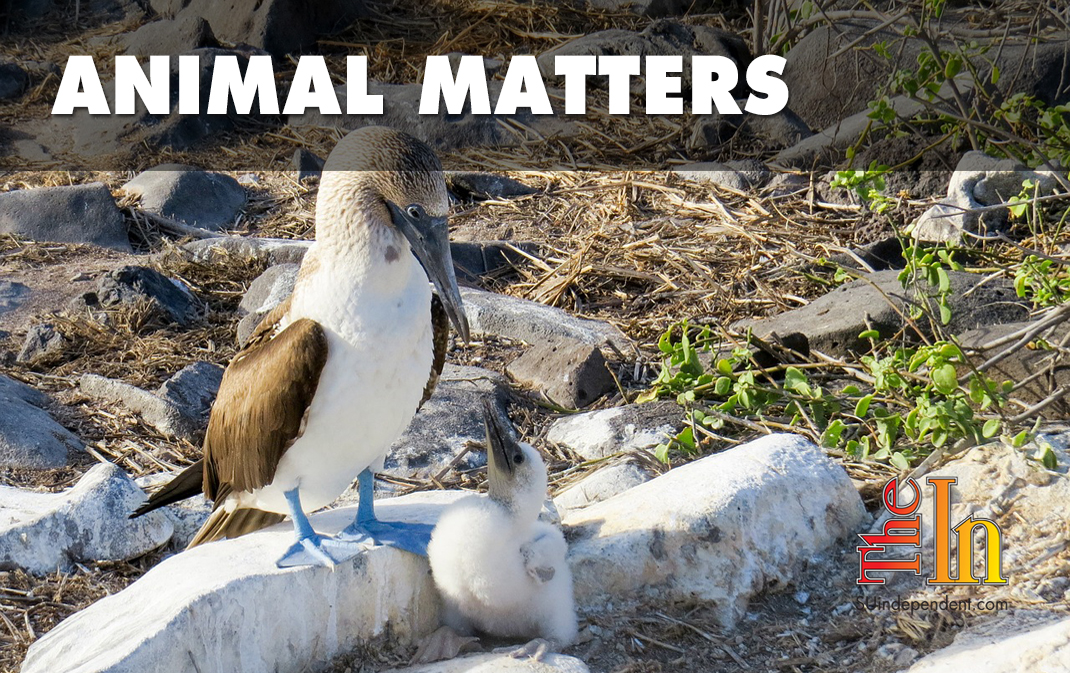
Animal Matters: Lessons from the Galapagos
Before visiting the Galapagos Islands, I thought I understood the theory of evolution. I didn’t. There is so much more than man evolving from apes or mutant genes creating mayhem, although those mutant genes have the right idea. For instance, I always thought of the iguana as a large land lizard that understands the need to exfoliate to maintain it’s scaly magnificence. What I didn’t know is that a few lucky iguanas found their way from the Amazon to Galapagos and evolved into swimming (marine) iguanas to adapt to their new environment. They eat kelp and bury their eggs in the sand. These hatch and emerge after a few months but do not receive any parental care at all. That’s resilience and a nifty survival skill!
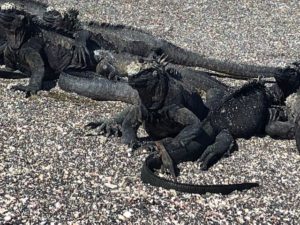 I also didn’t know that iguanas are different colors to blend in with their environment. Those that live on volcanic islands are black. An entire colony on volcanic rock is easy to miss unless you look closely. However, the most impressive feature is the fact that iguanas can actually change their skeletal structure to respond to a scarcity or abundance of food by becoming smaller or larger. I wish I could do that, and I’m guessing I’m not alone. How handy to become taller and skinnier at will — that has all kinds of potential!
I also didn’t know that iguanas are different colors to blend in with their environment. Those that live on volcanic islands are black. An entire colony on volcanic rock is easy to miss unless you look closely. However, the most impressive feature is the fact that iguanas can actually change their skeletal structure to respond to a scarcity or abundance of food by becoming smaller or larger. I wish I could do that, and I’m guessing I’m not alone. How handy to become taller and skinnier at will — that has all kinds of potential!
The many birds of Galapagos are amazing and unique. The Darwin’s finches, along with other species of plants and animals, provided the necessary evidence for the development of what would become one of the most brilliant theories in science: evolution.
Most people know about the blue-footed boobies. They seem to be the favorite “boobie.” When we did get to an island inhabited by people, most of the touristy trinkets and clothing were emblazoned with blue-footed boobies and sayings such as “I love boobies” — I’m not making this up. I now have a hat that says that. However, what I didn’t realize is that there are red-footed and Nazca boobies as well. The three species do not compete for food since they fish in different places. I think that is an important survival skill, perhaps akin to eating locally sourced food.
I am fascinated by the flightless cormorant. If Charles Darwin had seen this strange and unique bird, perhaps he would have developed and released his theory on the evolution of species earlier. The flightless cormorant adapted from a flying to a flightless species over generations. It is thought that when their ancestors flew to the Galapagos thousands of years ago, they found an ecosystem where it was not necessary to fly because of a lack of predators and easy access to food sources. I think flying is a valuable skill, though, and wish I could do it without a plane. Life would be so much easier.
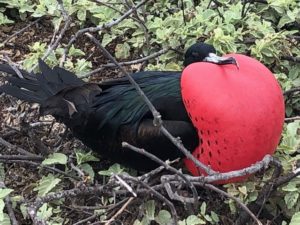 The frigate birds are kind of obnoxious. They are scavengers and take fish from other birds. They can perform all sorts of aerial maneuvers. Almost 70 percent of its body weight comprises specialized flying muscles. During the mating season, the male inflates his gular sac to attract the attention of females. We happened to be there during mating season and were able to observe the showy display of “maleness.” It reminds me of the flashiness of the disco era and some current-day politicians. Just saying.
The frigate birds are kind of obnoxious. They are scavengers and take fish from other birds. They can perform all sorts of aerial maneuvers. Almost 70 percent of its body weight comprises specialized flying muscles. During the mating season, the male inflates his gular sac to attract the attention of females. We happened to be there during mating season and were able to observe the showy display of “maleness.” It reminds me of the flashiness of the disco era and some current-day politicians. Just saying.
Galapagos penguins have evolved to be smaller, sleeker, and faster than their counterparts. They are excellent swimmers and can reach speeds up to 24 miles per hour. They are monogamous, and body fat is an asset. Maybe in my next life.
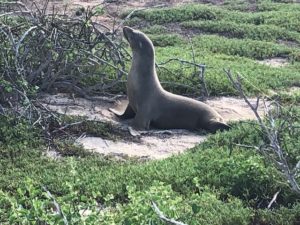 Even though sea lions are cute, we learned to give them space and never touch them. Males can be aggressive with any intruder who intentionally or unintentionally invades their territory. We witnessed a mishap when a sea lion chased someone from our group who just happened to be in the wrong place. Nevertheless, they are generally docile and playful, and everyone came home with magnificent sea lion videos.
Even though sea lions are cute, we learned to give them space and never touch them. Males can be aggressive with any intruder who intentionally or unintentionally invades their territory. We witnessed a mishap when a sea lion chased someone from our group who just happened to be in the wrong place. Nevertheless, they are generally docile and playful, and everyone came home with magnificent sea lion videos.
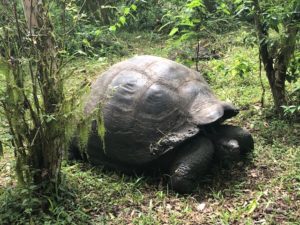 Of course, any trip to the Galapagos would not be complete without observing giant land tortoises. Until a few decades ago, they were prized by man for their meat, their oil (which is commercialized), the water in their bodies, and the fact that they can remain up to a year or more without eating or drinking, making them excellent sources for a long ocean voyage. After predation by humans, their populations were reduced almost to the point of extinction. Thanks to current conservation efforts, though, most are enjoying a protected resurgence, although Lonesome George died in 2012 and was the last survivor of the population of Pinta Island.
Of course, any trip to the Galapagos would not be complete without observing giant land tortoises. Until a few decades ago, they were prized by man for their meat, their oil (which is commercialized), the water in their bodies, and the fact that they can remain up to a year or more without eating or drinking, making them excellent sources for a long ocean voyage. After predation by humans, their populations were reduced almost to the point of extinction. Thanks to current conservation efforts, though, most are enjoying a protected resurgence, although Lonesome George died in 2012 and was the last survivor of the population of Pinta Island.
There were many more incredible animal, plant, and mineral specimens that attest to the diversity and adaptability of our natural world. Everywhere we went, we saw evidence of human interference. There is still graffiti all over the rocks in some areas, which was a way for humans to communicate. That was before cell phones. Fortunately, that kind of behavior is no longer tolerated, and tourists are not allowed in Galapagos National Parks without a naturalist guide.
The lesson I learned from the Galapagos is that we, as humans, must learn to respect the environment and the other species we share our planet with before it is too late. All animals matter.
Articles related to “Animal Matters: Lessons from the Galapagos”
I wish I’d known earlier how easily I’d lose weight on a plant-based diet
Do we really need Dow AgroSciences to test pesticide on beagles?
Free spaying and neutering programs help both feline and human populations




Laurie.
Thanks for your latest on the Galapagos. As a geologist/paleontologist I’ve used the fauna and flora on those islands, along with the geological origin of them, in many lectures…
Anyway, I thought you might be interested in an article I wrote for the Independent last July. Here is the link.
http://suindependent.com/sharing-earth-living-things/